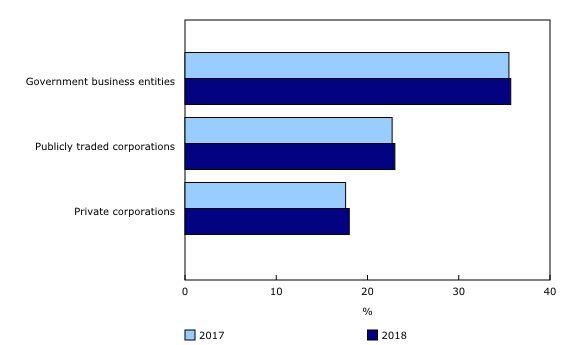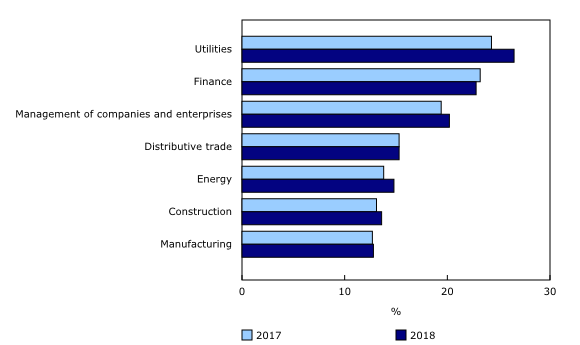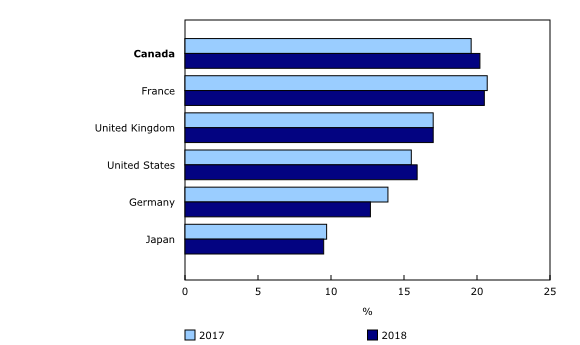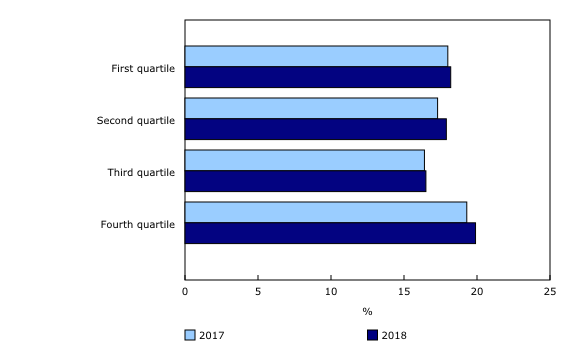Representation of women on boards of directors, 2018
Archived Content
Information identified as archived is provided for reference, research or recordkeeping purposes. It is not subject to the Government of Canada Web Standards and has not been altered or updated since it was archived. Please "contact us" to request a format other than those available.
Released: 2021-03-23
Statistics Canada is releasing new data on the gender composition of corporate boards in Canada in 2017 and 2018. These data highlight women in leadership and strategic decision-making roles in corporations that conduct business in Canada. They also support gender-based analysis across government and private-sector organizations.
Additional information and other studies and statistics related to gender and enterprises can be found in the Gender, Diversity and Inclusion Statistics Hub and in the business performance and ownership statistics portal.
Generally, directors supervise and manage the activities of a corporation. Directors sit on the board of directors—the governing body of a corporation.
Women were slightly more likely to hold board seats in 2018 than in 2017
A total of 5,128 women sat on a board of directors in 2018, representing 18.3% of all directors (28,071). The share of women on boards was lower in 2017 (17.9%), with a similar number of women directors (5,174) and a higher total number of directors (28,972). The dataset contained 9,232 corporations in 2018—a decrease from the 9,400 enterprises recorded in 2017.
Women who were newly appointed as directors in 2018 were more likely (20.6%) to sit on a board of directors than those appointed in both years (17.8%).
Almost two-thirds of corporate boards were composed entirely of male directors in 2017 and 2018. Just over 1 in 10 boards of directors had more than one woman, and over one in four had one woman director among its members.
Within the boards of directors included in the 2017 and 2018 dataset, female representation increased slightly, from 18.1% to 18.3%. Conversely, newly recorded corporations in the 2018 dataset had a slightly lower share of women (18.0%).
Government business entities have the highest share of women on boards
A higher number of women occupied a director position on boards of government business entities, in which more than one-third of members were women in 2017 and 2018. This is followed by publicly traded companies, where 22.7% and 23.0% of members were women in 2017 and 2018, respectively. The representation of women was lower on the boards of privately held corporations, where less than one in five directors was a woman for the two consecutive years.
The share of publicly traded corporations with at least one women director increased by 4.3% to 56.5% in 2018. Conversely, the proportion of private corporations with at least one woman on their board remained stable at 37.0%.
Canada amended the Canada Business Corporations Act in 2018, requiring some publicly traded corporations to present to shareholders the regulations put in place to foster diversity on boards of directors. As a result of this regulation, some corporations have set targets for the representation of women on boards, the majority of which are between 30% and 40%. One-third of publicly traded companies (34.1%) reached the target of at least 30% in 2018, an increase of 2.2% from 2017, while just over one-quarter of private corporations met this threshold in 2017 (27.9%) and 2018 (27.7%).
Utilities and finance sectors have largest share of women on corporate boards
Service industries had the highest representation of women directors. In particular, the boards of directors of the utilities sector had the highest proportion of women in the two consecutive years and the highest growth (+2.2%), rising from 24.3% in 2017 to 26.5% in 2018. The finance sector followed with a share of 22.8% of women directors in 2018, despite a slight decline of 0.4% from the previous year. In contrast, the manufacturing sector recorded the lowest proportion of women in 2017 and 2018, with less than 13.0% of women members.
At the same time, more than 4 in 10 corporate boards (44.2%) operating in the utilities sector met the target of 30% of women directors in 2018—an increase of 7.8% from 2017. More than one-third of corporations in the finance industry (37.1% in 2017 and 34.6% in 2018) reached this target, while one in five corporate boards in the manufacturing sector met this target in both years.
Corporations controlled by French and Canadian entities have the highest share of women on their boards
In 2018, women were more likely to hold a director seat on boards controlled by entities from France, where 20.5% of board members were women, followed closely by Canadian-controlled entities (20.2%). Female representation increased the most (+0.6%) in Canadian-controlled corporations, while French-controlled entities reported a decline of 0.2% from the previous year.
Women were less likely to be represented on the corporate boards of Japanese-controlled corporations, where less than 1 in 10 directors was a woman (9.7% in 2017 and 9.5% in 2018).
Among all of the countries of control, gender diversity was highest among publicly traded corporations under Canadian control—women held 28.8% of the seats in 2017 and 29.0% in 2018. Private corporations controlled by entities from France came in second place—women represented 21.0% of board members in 2017 and 20.6% in 2018.
The largest corporations display the highest representation of women
Assets, which refer to all resources owned by a corporation, are considered a good indicator of a corporation's size.
The share of women was highest in the largest corporations—i.e., those in the fourth quartile—where almost one-fifth of directors were women (19.3% in 2017 and 19.9% in 2018). The largest corporations tend to have more board members than smaller corporations. Therefore, they are more likely to have women as directors. For example, for large corporations with boards composed of five or more directors, 77.7% of them had at least one woman member in 2018 (versus 78.1% in 2017), compared with 64.7% of smaller corporations (versus 59.1% in 2017).
The smallest corporations—i.e., those in the first quartile—were slightly less likely than larger corporations to have women directors (18.0% in 2017 and 18.2% in 2018). Although the representation of women was lower in medium-sized corporations, small corporations still had a relatively high share of women directors, which is partly explained by the industry composition of the first quartile. Corporations operating in the finance sector and the management of companies and enterprises sector dominated the first quartile.
Corporations in the second and fourth quartiles recorded the highest growth, with an increase of 0.6%.
Note to readers
Data sources and methodology
The Corporations Returns Act (CRA) program collects financial and ownership data on corporations conducting business in Canada for public, private and government businesses. Corporations are included in the sample if their gross revenues for a fiscal period exceed $200 million, their assets exceed $600 million or their long-term debt or equity owing to non-residents exceeds a book value of $1 million.
However, while these data are used to understand the domestic and foreign residence of corporate board members, they cannot provide information on the gender profile of these individuals.
To identify the gender of these corporate board members, a two-step process was undertaken.
First, the data were integrated, where possible, with gender data from the Derived Record Depository—a national dynamic relational database containing only the basic personal identifiers of Canadians and built by integrating information from administrative data files available at Statistics Canada, including the T1 Personal Master file, for the purpose of facilitating the integration of data from other files.
Then, for the records that could not be integrated, probabilistic imputation was employed using information available about the corporate board members.
The data obtained through the CRA program are used to evaluate the extent of foreign control in the Canadian economy and are summarized in an annual report to Parliament. To release information from the CRA program, Statistics Canada must receive approval from Parliament.
The corporations targeted by the CRA represent a subsample of the total population of incorporated enterprises operating in Canada, which are included in the Annual Financial and Taxation Statistics for Enterprises (AFTS). The CRA publishes statistical estimates at the legal entity level, while the AFTS disseminate statistical estimates at the enterprise level. Because the AFTS assets are consolidated, there is an overrepresentation of assets in the CRA when compared with the assets in the AFTS.
Table
The data table used for this analysis will be available on March 26, 2021 (Table 33-10-0218-01 – Representation of men and women on boards of directors).
References
Information on the representation of women on boards of publicly traded corporations following the application of the new regulation of the Canada Business Corporations Act was taken from the following publication: Institut sur la gouvernance d'organisation privées et publiques: "Les enjeux de la diversité à la direction et aux conseils d'administration des sociétés ouvertes" (February 2021) (in French only).
Revision policy
Statistical revisions are carried out annually to incorporate the most current information available. Generally, these revisions are limited to the previous reference year.
Periodically, comprehensive revisions could be conducted, which would generally entail revisions beyond the scope of the standard revision window. These provide an opportunity to enhance estimation methods and incorporate improved data sources and concepts.
Sources of revisions
The revisions to data for reference year 2017 came primarily from an update of the 2017 dataset and from methodological enhancements. These revisions are described below.
As a result of these revisions, new benchmark information is available with the use of additional sources, notably, the use of tax data information to ensure that most of the units met the inclusion criteria of the Corporations Returns Act. Furthermore, the units that were inactive within the reference year based on the administrative data files and that reported tax revenues lower than $30,000 were removed.
Impact of the revisions
Data on the gender of board directors for reference year 2017 were revised from 31,266 directors to 28,972. The proportion of women board directors for the reference year 2017 was revised down to 17.9% from 18.1%. While the proportion of women decreased 0.2% from previously released numbers, the growth rate of director seats held by women increased 0.4%.
Contact information
For more information, or to enquire about the concepts, methods or data quality of this release, contact us (toll-free 1-800-263-1136; 514-283-8300; STATCAN.infostats-infostats.STATCAN@canada.ca) or Media Relations (613-951-4636; STATCAN.mediahotline-ligneinfomedias.STATCAN@canada.ca).
- Date modified:





